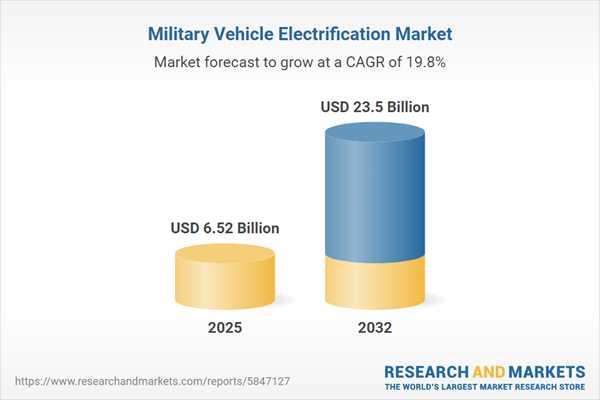Speak directly to the analyst to clarify any post sales queries you may have.
The military vehicle electrification market is rapidly transforming global defense mobility, presenting defense sector leaders with new pathways to operational efficiency, resilience, and sustainability. Demand for low-emission, adaptable, and high-endurance platforms is driving innovation as defense agencies and contractors respond to shifting operational requirements and regulatory landscapes.
Market Snapshot: Military Vehicle Electrification Market
The Military Vehicle Electrification Market grew from USD 5.54 billion in 2024 to USD 6.52 billion in 2025. This robust growth reflects a forecasted compound annual growth rate (CAGR) of 19.78%, with the market expected to reach USD 23.50 billion by 2032.
Scope & Segmentation
- Component: Cooling systems (fans, heat exchangers), energy storage systems, power generation (batteries—including lead-acid, lithium-ion/lithium-polymer, nickel metal hydride—and fuel cells), propulsion systems, and transmission systems.
- Platform Type: Combat vehicles (air defense vehicles, armored amphibious vehicles, infantry fighting vehicles, main battle tanks, mortar carriers, self-propelled howitzers, weapon systems armored personnel carriers), support vehicles (command & control vehicles, repair & recovery vehicles, supply trucks—ambulance, ammunition replenishment vehicles, fuel trucks), and unmanned armored vehicles.
- Technology: Fully electric and hybrid powertrains supporting varied mission profiles.
- Voltage Type: High voltage (more than 600 V), medium voltage (50-600 V), low voltage (less than 50 V).
- Application: Combat operations, communication and electronics, logistics and supply support, reconnaissance missions.
- End Users: Air force, army (regular infantry, special forces), and navy divisions.
- Regions: Americas (North America—United States, Canada, Mexico; Latin America—Brazil, Argentina, Chile, Colombia, Peru); Europe, Middle East & Africa (Europe—United Kingdom, Germany, France, Russia, Italy, Spain, Netherlands, Sweden, Poland, Switzerland; Middle East—UAE, Saudi Arabia, Qatar, Turkey, Israel; Africa—South Africa, Nigeria, Egypt, Kenya); Asia-Pacific (China, India, Japan, Australia, South Korea, Indonesia, Thailand, Malaysia, Singapore, Taiwan).
- Leading Companies: Key players include Alkè S.r.l., AM General LLC, BAE Systems PLC, Denchi Group Ltd., EnerSys, General Dynamics Corporation, Lockheed Martin Corporation, Northrop Grumman Corporation, Rheinmetall AG, Saft Groupe SAS by TotalEnergies, Textron Systems Corporation, Milrem Robotics OÜ, Nikola Corporation, and others.
Key Takeaways for Senior Decision-Makers
- Electrification enhances operational agility by enabling quieter, low-signature power generation, supporting covert missions and improved survivability in contested arenas.
- Integrating advanced battery chemistries and hybrid propulsion systems is shifting maintenance needs and extending platform endurance under demanding field conditions.
- Supply chains are undergoing change, as recent tariff policies in the United States prompt contractors to localize production, invest in innovation, and strengthen domestic sourcing.
- Strategic partnerships between defense primes and automotive technology firms are accelerating the adoption of commercial electric vehicle advancements for military applications.
- Regional development trends vary: the Americas prioritize technological sovereignty; EMEA leverages shared regulatory frameworks and joint R&D investment; Asia-Pacific focuses on rapid modernization and indigenous capabilities.
- Successful navigation of regulatory and policy-driven shifts is central to future-proofing vehicle fleets and building technological resilience.
Tariff Impact: Strategic Considerations in North America
Incoming U.S. tariff measures on battery cells, semiconductors, and power inverters are reshaping market dynamics by pressuring defense prime contractors and system integrators to reassess sourcing strategies and shift procurement toward domestic suppliers. These changing structures may temporarily challenge component availability and input costs, yet are expected to catalyze innovation, reinforce local industry, and incentivize long-term contracts with greater flexibility and resilience across North American and allied supply chains.
Methodology & Data Sources
This analysis is grounded in a rigorous methodology combining primary research—including interviews with defense procurement officials, system integrators, and technology developers—and secondary research from defense whitepapers, technical journals, policy documents, and open-source intelligence. Data triangulation ensures high validity by confirming findings against multiple reputable sources.
Why This Report Matters
- Senior leaders gain actionable insights into the implications of electrification, helping to prioritize investments in modular design, domestic supply chains, and regulatory engagement.
- The report equips decision-makers with segment-specific intelligence, supporting tailored strategies for new technology adoption, risk mitigation, and operational deployment.
- Comparative regional analysis enables clear identification of growth opportunities and collaboration avenues across key international markets.
Conclusion
Adopting electrification in military vehicles is essential for agility, operational endurance, and energy resilience in evolving defense scenarios. Proactive adaptation to technological and regulatory developments will differentiate market leaders. This report offers a reliable foundation for impactful, future-oriented decision-making.
Additional Product Information:
- Purchase of this report includes 1 year online access with quarterly updates.
- This report can be updated on request. Please contact our Customer Experience team using the Ask a Question widget on our website.
Table of Contents
3. Executive Summary
4. Market Overview
7. Cumulative Impact of Artificial Intelligence 2025
Companies Mentioned
The companies profiled in this Military Vehicle Electrification market report include:- Alkè S.r.l.
- AM General LLC
- AMETEK, Inc.
- Aspen Systems
- BAE Systems PLC
- Canoo, Inc.
- Denchi Group Ltd.
- EaglePicher Technologies by Tuthill Corporation
- EnerSys
- Epsilor-Electric Fuel Ltd.
- FFG Flensburger Fahrzeugbau GmbH
- General Dynamics Corporation
- GM Defense LLC
- GS Yuasa Lithium Power
- Honeywell International Inc.
- Leonardo S.p.A.
- Lithium Ion Technologies LLC
- Lockheed Martin Corporation
- Magnetic Systems Technology Limited
- Mega Engineering Vehicles Inc.
- Northrop Grumman Corporation
- Oshkosh Corporation
- Polaris Inc.
- QinetiQ Group
- RENK Group AG
- Rheinmetall AG
- Saft Groupe SAS by TotalEnergies
- Stryten Energy LLC
- Textron Systems Corporation
- Thales Group
- Arquus S.A.S. by John Cockerill Group
- Aselsan A.Ş.
- Ballard Power Systems Inc.
- Milrem Robotics OÜ
- Nikola Corporation
- Otokar Otomotiv ve Savunma Sanayi A.Ş.
Table Information
| Report Attribute | Details |
|---|---|
| No. of Pages | 187 |
| Published | November 2025 |
| Forecast Period | 2025 - 2032 |
| Estimated Market Value ( USD | $ 6.52 Billion |
| Forecasted Market Value ( USD | $ 23.5 Billion |
| Compound Annual Growth Rate | 19.7% |
| Regions Covered | Global |
| No. of Companies Mentioned | 37 |









